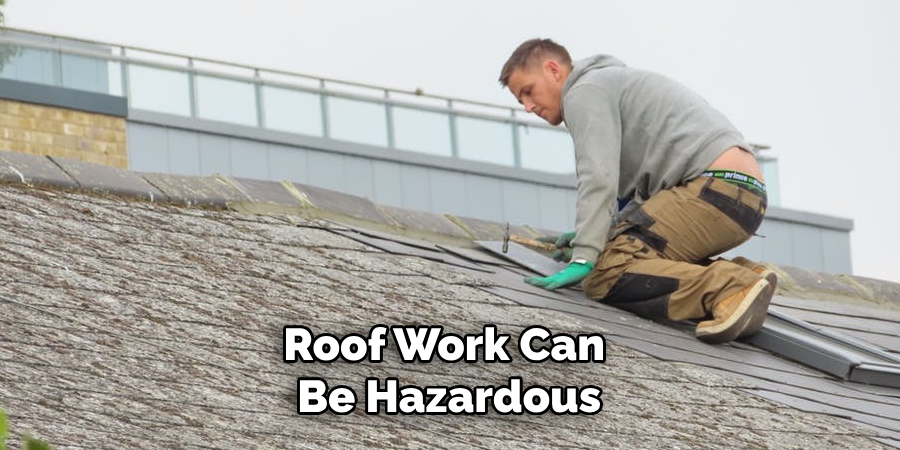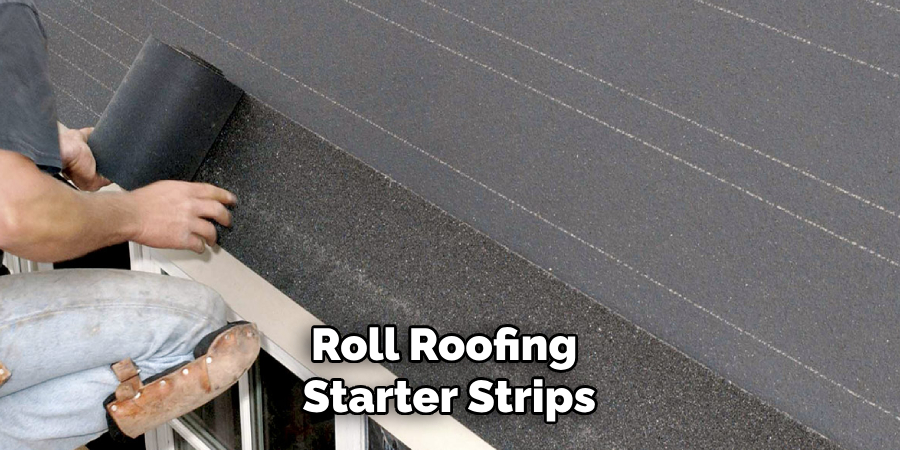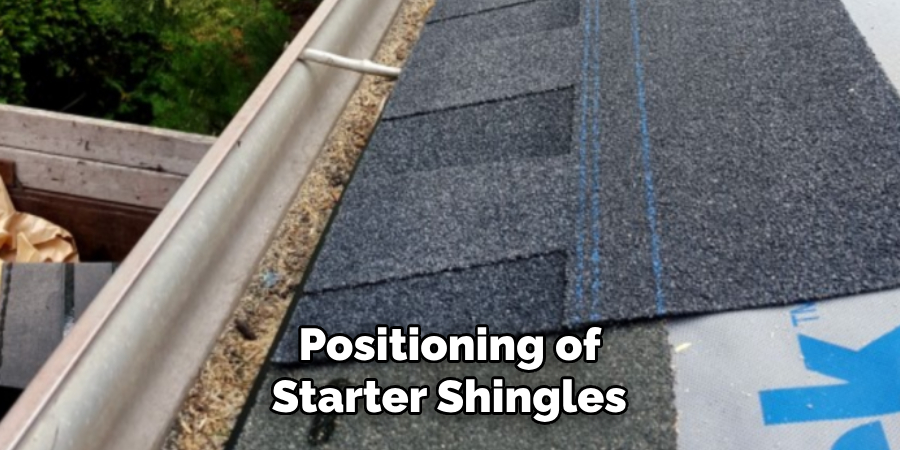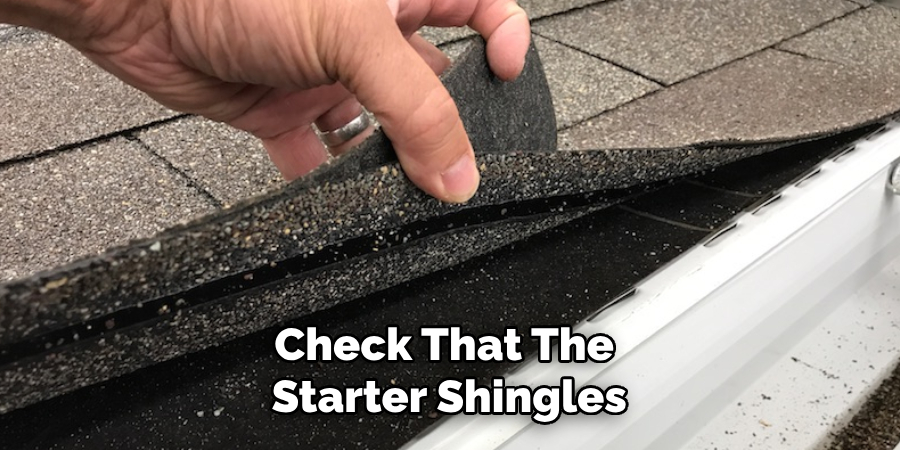Using starter shingles is a crucial step in the process of installing asphalt roofing shingles, providing a foundation for the rest of the roofing materials and ensuring a watertight seal along the eaves and rake edges.

While often overlooked, starter shingles play a vital role in protecting the roof from wind-driven rain and preventing water infiltration, ultimately prolonging the lifespan of the entire roofing system. In this comprehensive guide, we’ll delve into the importance of starter shingles and explore how to use starter shingles.
From selecting the right type and size of starter shingles to properly positioning and fastening them, you’ll gain valuable insights into maximizing their effectiveness and durability.
Whether you’re a seasoned roofer or a DIY enthusiast, mastering the use of starter shingles will enhance the quality and longevity of your roofing projects, ensuring superior protection and performance for years to come.
Importance of Starter Shingles in Roof Installation
The role of starter shingles in roof installation cannot be overstated. These specialized shingles are designed to be installed at the edges of the roof before the main roofing shingles are laid down, serving as the first line of defense against the elements.
One critical function of starter shingles is their ability to prevent wind uplift at the edge of the roof, which is essential for maintaining the overall stability of the roofing system during high winds.
Additionally, starter shingles are equipped with an adhesive strip that seals the edges of the roof, providing an extra layer of protection against water seepage.
Without this initial layer, the roof’s edge would be vulnerable to water damage and leaks, potentially compromising the structural integrity of the entire roofing system.
Therefore, the correct installation of starter shingles is a key factor in ensuring the roof’s long-term performance and durability, safeguarding the building from potential weather-related damage.
Understanding Starter Shingles
Starter shingles are distinct components in the roofing process that serve a foundational role.
Before the main shingles are installed, these starter shingles are laid out, typically along the eaves and rakes of the roof.
They’re designed specifically with a straight edge and do not have the same cutouts or tabs as standard shingles, which is intentional to ensure a clean and effective seal at the roof’s edge.
This design characteristic is crucial for providing a uniform base for the first row of main shingles, ensuring they align properly and securely.
Another key aspect of starter shingles is their composition.
They often contain a higher concentration of adhesive material, which is vital for bonding the bottom of the first course of shingles to the roof, creating a tight seal that reduces the risk of shingle blow-off and water infiltration.

This is particularly important in areas prone to high winds or heavy rainstorms, where the risk of weather-related damage is elevated.
In essence, understanding starter shingles is understanding their role in preemptively addressing potential weak points in a roof’s design, thereby fortifying the structure against adverse weather conditions.
By starting the roofing process with these specialized shingles, contractors and DIYers alike can ensure a higher level of protection for the entire roofing system.
Types of Starter Shingles Available
Starter shingles come in various types, each designed to meet different roofing requirements and preferences. The primary types include:
- Strip Shingles: These are the most basic form of starter shingles and are essentially a single layer of asphalt shingle material. They are cut in strips and often used for their simplicity and effectiveness in providing a straight edge and adhesive quality at the roof’s edge.
- Roll Roofing Starter Strip: This type offers a roll of material that can be cut to size, providing a quick and efficient method of covering the roof’s eave edge. It is especially useful for larger projects where speed and ease of installation are priorities.
- Self-Adhesive Starter Shingles: These shingles come with a self-adhesive backing that makes installation straightforward. The adhesive enhances the seal against wind and water, making them an excellent choice for areas prone to severe weather.
- Specialty Starter Shingles: Some shingles are designed to match specific high-end architectural shingles in terms of color, shape, and material. These are used when the aesthetic continuity of the roofing material is crucial for the project.
Each type of starter shingle has its advantages and specific applications, depending on the roofing project’s requirements. Whether it is for their ease of use, enhanced sealing capabilities, or aesthetic matching, the choice of starter shingles can significantly impact the overall effectiveness and durability of the roofing system.
Benefits of Using Starter Shingles

The incorporation of starter shingles into roofing projects comes with several key benefits that contribute to the longevity and efficiency of a roofing system. Here are the primary advantages of using starter shingles:
- Enhanced Wind Resistance: Starter shingles are specifically designed to provide strong resistance against wind uplift. This is crucial for preventing damage or removal of shingles during high wind events, thereby maintaining the roof’s integrity over time.
- Improved Water Barrier: By creating a tighter seal at the eaves and rake edges, starter shingles significantly reduce the risk of water infiltration. This preventive measure helps avoid water damage to the roof deck and the interior of the building, a common concern for homeowners.
- Increased Durability: When properly installed, starter shingles add an extra layer of durability to the roofing system. Their design and adhesive properties help in holding the first row of shingles firmly in place, contributing to the overall sturdiness of the roof.
- Ease of Installation: Many starter shingle options are designed for quick and easy installation, which can save time and labor costs. Self-adhesive and roll roofing starter strips, for example, can expedite the roofing process while ensuring a secure fit.
- Aesthetic Appeal: For projects where appearance is a key consideration, specialty starter shingles offer the ability to match the look of the main shingles. This ensures a uniform and visually appealing edge to the roof, enhancing the property’s curb appeal.
In sum, starter shingles play an essential role not only in the foundational aspects of roofing but also in elevating the overall performance and appearance of the roof. Their use is a critical best practice in modern roofing, providing clear benefits in terms of protection, longevity, and aesthetic quality.
Preparing for Starter Shingle Installation

Preparing properly for starter shingle installation is crucial for ensuring the success and longevity of your roofing project. Before the actual installation begins, several preparatory steps must be undertaken to ensure the roof is ready to receive the starter shingles. Here are key preparation steps:
- Inspect the Roof Deck: The first step involves a thorough inspection of the roof deck to ensure it is in good condition, free of damage, and structurally sound. Any areas of rot or damage should be repaired or replaced to provide a stable base for the shingles.
- Install Underlayment: Before laying the starter shingles, it’s essential to roll out and secure a water-resistant underlayment over the roof deck. This layer provides additional protection against water infiltration and is a critical component of the roofing system.
- Measure and Mark the Roof: Accurate measurements and clear markings on the roof deck are critical for the correct placement of starter shingles. This step ensures that the starter shingles are aligned properly, providing a uniform edge for the subsequent layers of shingles.
- Gather Necessary Tools and Materials: Ensure all tools, such as a roofing nail gun, hammer, utility knife, and measuring tape, are on hand. Also, verify that you have enough starter shingles, nails, and any other materials required for the installation.
- Review Installation Instructions: Each type of starter shingle may come with specific installation instructions from the manufacturer. Review these guidelines carefully to ensure compliance with best practices and warranty requirements.
- Prepare the Edges of the Roof: If installing drip edges (recommended), ensure they are in place along the eaves and rakes before installing the starter shingles. Drip edges help direct water away from the roof deck and are an essential component for water management in roofing systems.
- Ensure Safety Measures: Roof work can be hazardous. Prior to starting installation, ensure all safety equipment, like harnesses, gloves, and non-slip boots, are prepared and that ladders and scaffolding are securely positioned.

By meticulously preparing for the installation of starter shingles, you can significantly enhance the efficiency of the installation process and the overall performance of the roofing system. Proper preparation not only facilitates a smoother installation process but also contributes to the durability and longevity of the roof.
Gathering Necessary Tools and Materials
Before commencing the installation of starter shingles, assembling the appropriate tools and materials is vital for an efficient and effective process. The following are essential items needed for starter shingle installation:
- Roofing Nails: Ensure you have the correct size and type of nails as recommended by the shingle manufacturer. These nails are used to secure the starter shingles to the roof deck.
- Hammer or Roofing Nail Gun: A roofing nail gun can significantly speed up the process, though a hammer is also suitable for smaller jobs or where precision is paramount.
- Utility Knife: A sharp utility knife is essential for trimming shingles to the correct size, especially along edges and around obstacles like vents and pipes.
- Measuring Tape: Precise measurements are crucial for proper shingle placement, making a measuring tape an indispensable tool.
- Chalk Line: To ensure straight lines and uniform placement of shingles, a chalk line is used to mark the roof before installation begins.
- Starter Shingles or Roll Roofing Starter Strips: Depending on the project specifications, ensure you have a sufficient quantity of starter shingles or roll roofing starter strips to cover the necessary area.
- Underlayment: A water-resistant underlayment should already be laid out as part of the roof preparation, but having extra on hand for any adjustments is beneficial.
- Safety Equipment: Safety harnesses, safety glasses, gloves, and non-slip boots are mandatory to prevent accidents and injuries during roof work.

10 Methods How to Use Starter Shingles
01.Understanding the Purpose of Starter Shingles:
Starter shingles are the first line of defense for your roofing system. They are specifically designed to be installed along the eaves and rake edges of the roof to provide a secure base for the first course of standard shingles. Their primary function is to prevent wind-driven rain from infiltrating the roof deck, thus protecting the underlying structure from water damage.
02.Selecting the Right Type of Starter Shingles:
When choosing starter shingles, it’s essential to consider factors such as compatibility with the brand and style of asphalt shingles being installed, as well as the specific requirements of the roofing project. Pre-cut starter strips are typically made from the same material as standard shingles and come in convenient lengths for easy installation. On the other hand, starter shingle rolls offer flexibility in terms of length and can be tailored to fit the dimensions of the roof.
03.Ensuring Sufficient Overhang:
Proper overhang of starter shingles is critical for effective water drainage and protection of the roof edge. Along the eaves, starter shingles should extend past the drip edge by at least 1/4 to 3/4 inches to direct water away from the fascia and prevent it from wicking back under the shingles. Similarly, along the rake edges, starter shingles should overhang the gable edge to ensure complete coverage and proper water shedding.
04.Positioning Starter Shingles Correctly:

Proper positioning of starter shingles is essential for achieving a neat and uniform appearance while maximizing their effectiveness. Start by aligning the bottom edge of the starter shingles flush with the edge of the roof deck, ensuring that they are evenly spaced and parallel to each other. Pay close attention to maintaining a consistent overhang and straight line along the entire perimeter of the roof.
05.Securing Starter Shingles with Proper Fasteners:
To ensure the stability and durability of the roofing system, starter shingles should be securely fastened to the roof deck using roofing nails or staples. Drive the fasteners through the designated nailing line or adhesive strip on the starter shingles, following the manufacturer’s recommendations for spacing and placement. Proper fastening prevents uplift during high winds and helps maintain the integrity of the roofing installation.
06.Applying Adhesive to Enhance Bonding:
While fasteners provide mechanical attachment, applying roofing adhesive to the underside of starter shingles can further enhance bonding and improve wind resistance. Roofing adhesive is especially beneficial in areas prone to high winds or extreme weather conditions where additional reinforcement is needed. Apply a continuous bead of adhesive along the bottom edge of each starter shingle, ensuring full coverage for optimal adhesion.
07.Trimming Starter Shingles for Custom Fit:
In situations where standard starter shingles may not provide adequate coverage, custom-cutting starter shingles allows for precise fitting around roof features such as valleys, dormers, and chimneys. Use a utility knife or roofing scissors to trim starter shingles to the desired size and shape, ensuring a snug and tailored fit that maintains the integrity of the roofing system.
08.Ensuring Continuous Coverage:
Maintaining continuous coverage of starter shingles along the eaves and rake edges is essential for preventing water infiltration and ensuring uniform protection across the entire roof perimeter. Overlapping starter shingles at the joints helps create a seamless barrier against water penetration, minimizing the risk of leaks and water damage. Take care to align the overlapping edges properly and secure them in place to maintain a watertight seal.
09.Inspecting for Proper Alignment and Adhesion:

Once starter shingles are installed, it’s crucial to conduct a thorough inspection to verify proper alignment, overhang, and adhesion. Check that the starter shingles are evenly spaced and aligned along the roof edges, with consistent overhang and straight lines. Ensure that the adhesive strip is firmly bonded to the roof deck, providing secure attachment and preventing water infiltration.
Address any discrepancies or issues promptly to maintain the integrity of the roofing system and avoid potential problems down the line.
10.Following Manufacturer’s Guidelines and Best Practices:
Throughout the installation process, it’s essential to adhere to the manufacturer’s guidelines and industry best practices for using starter shingles effectively.
Familiarize yourself with the specific requirements and recommendations outlined in the product documentation, including installation instructions, fastening requirements, and adhesive application techniques.
Consult professional resources or roofing experts for guidance if needed, and take the time to learn proper techniques and procedures to ensure successful outcomes in your roofing projects.
Conclusion
In conclusion, mastering the proper installation of starter shingles is crucial for ensuring the durability and longevity of your roof.
By following the steps outlined in this guide, including proper alignment, overhang measurement, and securing techniques, you can effectively create a solid foundation for your roofing system.
Starter shingles play a vital role in protecting the edges of your roof from wind damage, water infiltration, and other potential issues.
Additionally, avoiding common mistakes and seeking professional advice when needed will help you achieve optimal results. Be sure to follow all instructions on how to use starter shingles carefully, and always consult an expert when in doubt.
